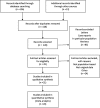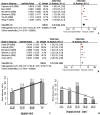Geographical prevalence and risk factors for pterygium: a systematic review and meta-analysis
- PMID: 24253031
- PMCID: PMC3840351
- DOI: 10.1136/bmjopen-2013-003787
Geographical prevalence and risk factors for pterygium: a systematic review and meta-analysis
Erratum in
-
Correction: Geographical prevalence and risk factors for pterygium: a systematic review and meta-analysis.BMJ Open. 2017 Dec 22;7(12):e003787corr1. doi: 10.1136/bmjopen-2013-003787corr1. BMJ Open. 2017. PMID: 29275352 Free PMC article. No abstract available.
Abstract
Objective: Pterygium is considered to be a proliferative overgrowth of bulbar conjunctiva that can induce significant astigmatism and cause visual impairment; this is the first meta-analysis to investigate the pooled prevalence and risk factors for pterygium in the global world.
Design: A systematic review and meta-analysis of population-based studies.
Setting: International.
Participants: A total of 20 studies with 900 545 samples were included.
Primary outcome measure: The pooled prevalence and risk factors for pterygium.
Results: 20 studies were included. The pooled prevalence of pterygium was 10.2% (95% CI 6.3% to 16.1%). The pooled prevalence among men was higher than that among women (14.5% vs 13.6%). The proportion of participants with unilateral cases of pterygium was higher than that of participants with bilateral cases of pterygium. We found a trend that the higher pooled prevalence of pterygium was associated with decreasing geographical latitude and age in the world. The pooled OR was 2.32 (95% CI 1.66 to 3.23) for the male gender and 1.76 (95% CI 1.55 to 2.00) for outdoor activity, respectively.
Conclusions: The pooled prevalence of pterygium was relatively high, especially for low latitude regions and the elderly. There were many modifiable risk factors associated with pterygium to which healthcare providers should pay more attention.
Keywords: Epidemiology; Ophthalmology.
Figures




References
-
- Li M, Zhu M, Yu Y, et al. Comparison of conjunctival autograft transplantation and amniotic membrane transplantation for pterygium: a meta-analysis. Graefes Arch Clin Exp Ophthalmol 2012;250:375–81 - PubMed
-
- Lu P, Chen X, Kang Y, et al. Pterygium in Tibetans: a population-based study in China. Clin Experiment Ophthalmol 2007;35:828–33 - PubMed
-
- Al-Bdour M, Al-Latayfeh M. Risk factors for pterygium in an adult Jordanian population. Acta Ophthalmol Scand 2004;82:64–7 - PubMed
-
- Threlfall TJ, English DR. Sun exposure and pterygium of the eye: a dose-response curve. Am J Ophthalmol 1999;128:280–7 - PubMed
LinkOut - more resources
Full Text Sources
Other Literature Sources
